|
For the medieval astronomer/astrologers the Universe was a small place, the
Earth was the center, and events in the heavens were orderly and designed to
benefit humanity. The only change that was deemed appropriate was cyclic change
such as the (mostly) orderly motion of the planets on the sky or the daily
travel of the sun around the heavens, for cyclic change returns one to the
starting point and so is not really change at all. In Europe of the Middle Ages
this belief was elevated to the level of religious dogma, and one dared
challenge this worldview at considerable personal peril.
However, the Copernican revolution began a long process that changed
completely our perception of the heavens and humanity's place in the Universe.
Beginning in the 16th and 17th centuries and continuing until today,
observations and increased theoretical understanding demonstrated that the
Universe is enormous, that it has existed for periods that dwarf human
lifetimes, and that we do not occupy the center of the Universe (for there is no
center). Probably less appreciated is a change with antecedents in events
observed hundreds of years ago, but that has accelerated at breathtaking pace
over the last 30 years. As observational astronomy at wavelengths other than
visible light (Radio-Frequency, X-Ray, Gamma-Ray, Ultraviolet, ...) has become
more commonplace, we have begun to appreciate that the Universe is party to
scenes of unimaginable violence. Far from an orderly stage for stately and
gentle physical processes, the Universe at various times and various places
undergoes violent cataclysms releasing energy on a scale to numb the mind of
even the most analytic physical scientist.
The medieval natural philosopher would perhaps have had even greater
difficulty accepting this insight than accepting the Copernican hypothesis that
the Earth was not the center of the Universe, for it would have destroyed the
strongly held belief that the Universe existed as a nurturing cocoon for
humanity. However, it is supremely ironic that these violent processes that on
the surface seem hostile to the place of humanity in the Universe are in fact
essential to the production of the present Universe. In particular, our modern
understanding is that there would be no matter as we know it, no life as we know
it, and no humanity to contemplate these questions, in the absence of violent
processes that would, of themselves, destroy all life within countless light years.
The development of these ideas has been a truly remarkable odyssey in the
history of human thought. These lectures represent an introduction to how this
modern worldview has come about, and a survey of the often beautiful, sometimes
astonishing, but never dull, Universe described by these evolving ideas.
Time and Scale
Our modern perception of the Universe has been drastically reshaped from the
corresponding perception of only a few hundred years ago.
Changing Perceptions of the Universe
Our understanding of the Universe with respect to it size, temporal duration, the kinds of events that take place
in it, and the kinds of objects that it contains has undergone serious revision in the last few centuries:
- Only in the last 400 years or so have we realized that the earth is not
the "center", and that the Universe is immense.
- The Sun would hold
1.3 million Earths.
- There are 200 billion "Suns"
in a galaxy like our own Milky Way Galaxy.
- Astronomers can see billions of galaxies.
- We don't know whether the Universe has an "end" or not; we are not
completely sure even of the full meaning of the question.
- Only in the last 50 years have we realized that the Universe is not
static.
- The entire Universe is
expanding.
- Events of
fantastic
violence take place in the Universe.
- In the last half-century we have come to believe that the Universe
contains objects that are truly bizarre as measured in human terms.
- Neutron Stars and
Pulsars
-
Black Holes
-
Quasars
-
Exploding and Colliding Galaxies
- Only in the last 200 years have we begun to appreciate the age of the Universe.
- The Universe is probably 10-20 billion years old.
- Our Solar System is probably 4-5 billion years old.
Thus, the Universe of the modern astronomer would be largely
unrecognizable to her counterpart from a few centuries ago. We can only
speculate whether our present understanding of the Universe will appear as
quaint 400 years from now as the views from 400 years ago appear to us.
A Sense of Scale
If the solar system were the size of a table, the
Andromedae Galaxy would lie at 10 times the distance to the moon and the most
distant galaxies would lie at 60 times the distance to the Sun.
A Sense of Time
If we were to compress the time since the Big Bang into one year, and make the time of the Big Bang January 1,
- The Earth was formed in mid-September.
- The mammals appeared on December 26.
- All human prehistory (from the first known stone tools) and history have occurred in the last 1/2 hour of
New Year's Eve.
Thus, all of human history is but a fleeting instant on the cosmic timescale.
The Celestial Sphere
Much of our initial discussion of Astronomy will concern the motion of
objects in the sky. Therefore, we shall introduce some terminology and a
coordinate system that allow us to specify succinctly the location of particular
objects in the heavens. For a more extensive discussion, see
Astronomy
without a Telescope.

The Celestial Sphere
It is useful in discussing objects in the sky to
imagine them to be attached to a sphere surrounding the earth. This fictitious
construction is called the celestial sphere. At any one time we see no
more than half of this sphere, but we will refer loosely to the imaginary
half-sphere over our heads as just the celestial sphere (see adjacent figure).
The point on the celestial sphere that is directly over our heads at a given
time is termed the zenith. The imaginary circle passing through the
North and South points on our horizon and through the zenith is termed the
celestial meridian. We will introduce additional terminology associated
with the celestial sphere later.
Motion in the SkyIt is clear after only minimal observation that
objects change their position in the sky over a period of time. This motion is
conveniently separated into two parts:
- The entire sky appears to turn around imaginary points in the northern and
southern sky once in 24 hours. This is termed the daily or diurnal
motion of the celestial sphere, and is in reality a consequence of the
daily rotation of the earth on its axis. The diurnal motion affects all
objects in the sky and does not change their relative positions: the
diurnal motion causes the sky to rotate as a whole once every 24 hours.
- Superposed on the overall diurnal motion of the sky is "intrinsic" motion
that causes certain objects on the celestial sphere to change their positions
with respect to the other objects on the celestial sphere. These are the
"wanderers" of the ancient astronomers: the planets, the Sun, and the Moon.
Diurnal motion at different latitudes
Actually, all objects are slowly changing their relative positions on the
celestial sphere, but for most the motion is so slow that it cannot be detected
over timespans comparable to a human lifetime; only the "wanderers" have
sufficiently fast motion for this change to be easily visible.
Celestial Coordinate Systems
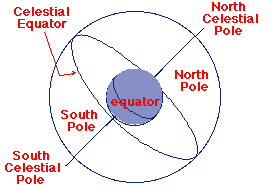 We can define a useful coordinate system for locating objects on the celestial sphere
by projecting onto the sky the latitude-longitude coordinate system that we use
on the surface of the earth. As illustrated in the adjacent figure, this allows
us to define "North and South Celestial Poles" (the imaginary points about which
the diurnal motion appears to take place) and a "Celestial Equator".
We can define a useful coordinate system for locating objects on the celestial sphere
by projecting onto the sky the latitude-longitude coordinate system that we use
on the surface of the earth. As illustrated in the adjacent figure, this allows
us to define "North and South Celestial Poles" (the imaginary points about which
the diurnal motion appears to take place) and a "Celestial Equator".
The figure illustrates that these imaginary objects are the exact analogs of
the corresponding imaginary objects on the surface of the earth. Thus, we shall
be able to specify the precise location of things on the celestial sphere by
giving the celestial analog of their latitudes and longtitudes, or something
related to those quantities.
The "Road of the Sun" on the Celestial Sphere
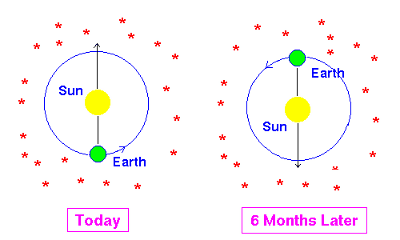 Another important imaginary object on the celestial sphere is the "ecliptic" or
"Road of the Sun", which is the imaginary path that the Sun follows on the
celestial sphere over the course of a year. As the diagram at left indicates,
the apparent position of the sun with respect to the background stars (as viewed
from Earth) changes continuously as the Earth moves around its orbit, and will
return to its starting point when the Earth has made one revolution in its
orbit.
Another important imaginary object on the celestial sphere is the "ecliptic" or
"Road of the Sun", which is the imaginary path that the Sun follows on the
celestial sphere over the course of a year. As the diagram at left indicates,
the apparent position of the sun with respect to the background stars (as viewed
from Earth) changes continuously as the Earth moves around its orbit, and will
return to its starting point when the Earth has made one revolution in its
orbit.
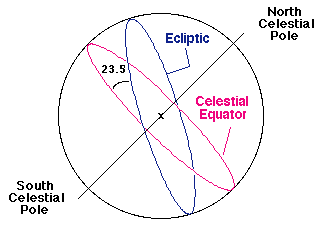 Thus, the Sun traces out a closed path on the celestial sphere once each year.
This apparent path of the Sun on the celestial sphere is called the
ecliptic. Because the rotation axis of the Earth is tilted by 23.5
degrees with respect to the plane of its orbital motion (which is also called
the ecliptic), the path of the Sun on the celestial sphere is a circle tilted by
23.5 degrees with respect to the celestial equator (see diagram at right).
Thus, the Sun traces out a closed path on the celestial sphere once each year.
This apparent path of the Sun on the celestial sphere is called the
ecliptic. Because the rotation axis of the Earth is tilted by 23.5
degrees with respect to the plane of its orbital motion (which is also called
the ecliptic), the path of the Sun on the celestial sphere is a circle tilted by
23.5 degrees with respect to the celestial equator (see diagram at right).
The ecliptic is important observationally, because the planets, the Sun (by
definition), and the Moon are always found near the ecliptic. As we shall see
later, this is because all of these objects have orbits that lie nearly in the
same spatial plane.
East and West on the Celestial Sphere
It is useful to define east and west directions on the celestial sphere, as illustrated in the following figure.
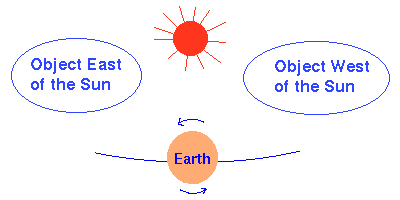
Thus, objects to the west of the Sun on the celestial sphere precede the Sun
in the diurnal motion of the celestial sphere (they "rise" before the Sun and
"set" before the Sun). Likewise, objects to the east of the Sun trail the Sun in
the diurnal motion (they "rise" after the Sun and "set" after the Sun).
Generally, one object is west of another object if it "rises" before the other
object over the eastern horizon as the sky appears to turn, and east of the
object if it "rises" after the other object.
Celestial Coordiante System
It is useful to impose on the celestial sphere a coordinate system that is
analogous to the latitude-longitude system employed for the surface of the
Earth. For a more extensive discussion, see
Astronomy
without a Telescope.
Right Ascension and Declination
This coordinate system is illustrated in
the following figure (for which you should imagine the earth to be a point at the center of the sphere).

The celestial coordinate system |
In the celestial coordinate system the North and South Celestial Poles are
determined by projecting the rotation axis of the Earth to intersect the
celestial sphere, which in turn defines a Celestial Equator. The celestial
equivalent of latitude is called declination and is measured in degrees
North (positive numbers) or South (negative numbers) of the Celestial Equator.
The celestial equivalent of longitude is called right ascension. Right
ascension can be measured in degrees, but for historical reasons it is more
common to measure it in time (hours, minutes, seconds): the sky turns 360
degrees in 24 hours and therefore it must turn 15 degrees every hour; thus, 1
hour of right ascension is equivalent to 15 degrees of (apparent) sky rotation.
Equinoxes and Solstices
The zero point for celestial longitude (that is,
for right ascension) is the Vernal Equinox, which is that intersection
of the ecliptic and the celestial equator near where the Sun is located in the
Northern Hemisphere Spring. The other intersection of the Celestial Equator and
the Ecliptic is termed the Autumnal Equinox. When the Sun is at one of
the equinoxes the lengths of day and night are equivalent (equinox
derives from a root meaning "equal night"). The time of the Vernal Equinox is
typically about March 21 and of the Autumnal Equinox about September 22.
The point on the ecliptic where the Sun is most north of the celestial
equator is termed the Summer Solstice and the point where it is most south of
the celestial equator is termed the Winter Solstice. In the Northern Hemisphere
the hours of daylight are longest when the Sun is near the Summer Solstice
(around June 22) and shortest when the Sun is near the Winter Solstice (around
December 22). The opposite is true in the Southern Hemisphere. The term
solstice derives from a root that means to "stand still"; at the
solstices the Sun reaches its most northern or most southern position in the sky
and begins to move back toward the celestial equator. Thus, it "stands still"
with respect to its apparent North-South drift on the celestial sphere at that time.
Traditionally, Northern Hemisphere Spring and Fall begin at the times of the
corresponding equinoxes, while Northern Hemisphere Winter and Summer begin at
the corresponding solstices. In the Southern Hemisphere, the seasons are
reversed (e.g., Southern Hemisphere Spring begins at the time of the Autumnal Equinox).
Coordinates on the Celestial Sphere
The right ascension (R.A.) and declination (dec) of an object on the celestial sphere specify its position
uniquely, just as the latitude and longitude of an object on the Earth's surface
define a unique location. Thus, for example, the star Sirius has celestial
coordinates 6 hr 45 min R.A. and -16 degrees 43 minutes declination, as illustrated in the following figure.

Right Ascension and Declination for Sirius |
This tells us that when the vernal equinox is on our celestial meridian, it
will be 6 hours and 45 minutes before Sirius crosses our celestial meridian, and
also that Sirius is a little more than 16 degrees South of the Celestial Equator.
Keeping your Perspective
Do not become confused because the perspectives
in the celestial sphere diagram and the sky segment diagram containing Sirius
are different. In the celestial sphere diagram one is imagining an outside
view of the celestial sphere (from a vantage point beyond the most distant
stars that we see with the naked eye). In the diagram showing the position of
Sirius in the sky the view is instead the actual sky as viewed from the
Earth (that is, from the center of the sphere in the first diagram).
Thus, the directions get reversed: moving to the right from the vernal
equinox in the first diagram will look like moving to the left as viewed from
its center, which is the perspective of the second diagram (that is, the actual
view of the sky from Earth). That direction, by convention, is chosen to be the
positive direction for right ascension.
Timekeeping
Historically, the regular motion of objects in the sky served as the basis
for timekeeping. The diurnal motion of the sky caused by the rotation of the
Earth on its axis defined the day, the year was defined by the motion of the
Earth on its orbit about the Sun, and the month was defined in relation to the
revolution of the Moon about the Earth. Although precise modern timekeeping is
done electronically, many of the details and the terminology of timekeeping
remain rooted in its astronomical heritage.
Sidereal Time and Solar Time
In using the sky for timekeeping, we must
define a reference point to determine when a cycle of the required motion has
been completed. If we choose a reference point afixed to the celestial sphere,
the corresponding time is being referenced to the distant stars and is termed
sidereal time. If instead we choose the Sun as the reference point, the
corresponding time is called solar time (or tropical time).
Technically, the sidereal time is defined as the length of time since the
vernal equinox has crossed the local celestial meridian. An equivalent
definition of the sidereal time is the right ascension of any star presently
located on the local celestial meridian. Thus, if the star Sirius is presently
on your celestial meridian, the sidereal time is 6 hours and 45 minutes because
we saw earlier that Sirius is located at 6 hr 45 min right ascension on the
celestial sphere. Generally our everyday (civil) time is referenced to the
(average) motion of the Sun, not the vernal equinox. Thus, sidereal time
generally does not coincide with the everyday (wall clock) time. To be precise,
the sidereal time agrees with the solar time only at the autumnal equinox; at
any other time, they differ (they are exactly 12 hours apart at the time of the
vernal equinox).
Sidereal Days and Solar Days
The sidereal day is defined to
be the length of time for the vernal equinox to return to your celestial
meridian. The solar day is defined to be the length of time for the Sun
to return to your celestial meridian. The two are not the same, as illustrated
in the following animation.
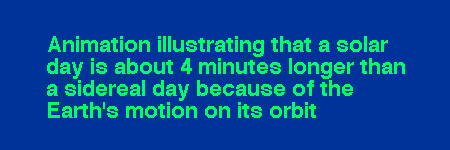 |
| The sidereal and solar day |
Because the Earth is in motion on its orbit around the Sun in the course of a
day, the Earth must turn about 4 minutes longer each day (3 minutes and 56
seconds, to be exact) to bring the Sun back to the celestial meridian than to
bring the vernal equinox back to the celestial meridian. Thus, the solar day is
3 minutes and 56 seconds longer than the sidereal day. It is this almost 4
minute per day discrepancy that causes the difference in sidereal and solar
time, and is responsible for the fact that different constellations are everhead
at a given time of day during the Summer than in the Winter.
Time Zones and Universal Time
As a matter of civil convenience, the Earth is divided into various
time zones.
The time for many astronomical events is given in
Universal Time
(UT), which is (approximately) the local time for Greenwich,
England---the Greenwich Mean Time or GMT. The conversion from UT to
local zone time may be made using
this map or this
set of links. Alternatively, here is a clickable
Java applet illustrating the world's timezones.
Calendars
There are two basic sources for calendars presently in use: the monthly
motion of the Moon (Lunar calendars) and the yearly motion of the Sun
(Solar Calendars). Examples of Lunar calendars still in use are the
traditional Jewish and Chinese calendars. The difficulty with Lunar calendars is
that the seasons are correlated with the Sun, not the Moon. Thus, Lunar
calendars require elaborate adjustments or translations to relate to the
seasons. That calendars correlate with seasons is now primarily a matter of
convenience, but in more ancient cultures keeping track of the seasons was
serious business: it could be a matter of survival to know things like the
proper time to plant to ensure a bountiful harvest.
The Roman Lunar Calendar
Our present calendar (called the Gregorian
Calendar) is a basically solar calendar that grew from what was originally
a Lunar calendar used by the Romans. The original calendar contained 10 months
of length 29 or 30 days. This was later modified to a 12 month calendar, but 12
months of average length 29.5 days gives only 354 days in the year, whereas the
orbital period of the Earth is 365.242199 days. Thus, at the end of each year
this calendar was 11 days out of step with the seasons and at the end of 3 years
it was almost a month out of step. This was initially corrected in an arbitrary
way by adding 13th months, but this was used for various political purposes and
soon threw the calendar into severe confusion.
The Julian Calendar
In 46 B.C., Julius Caesar reformed the calendar by
ordering the year to be 365 days in length and to contain 12 months. This forced
some days to be added to some of the months to bring the total from 354 up to
365 days, so the months now were out of phase with the cycles of the Moon:
although the Julian Calendar retained monthly divisions, it was no
longer a Lunar calendar. The Julian Calendar improved things tremendously, but
there was still about a quarter day difference between the true length of the
year and the 365 days assumed for the Julian Calendar. Thus, February was given
an additional day every 4 years (leap years) and the average length of
the Julian year with leap years added was 365.25 days.
The Gregorian Calendar
However, the Julian year still differs from the
true year of 365.242199 days by 11 minutes and 14 seconds each year, and over a
period of 128 years even the Julian Calendar was in error by one day with
respect to the seasons. By 1582 this error had accumulated to 10 days and Pope
Gregory XIII ordered another reform: 10 days were dropped from the year 1582, so
that October 4, 1582, was followed by October 15, 1582. In addition, to guard
against further accumulation of error, in the new Gregorian Calendar it
was decreed that century years not divisible by 400 were not to be considered
leap years. Thus, 1600 was a leap year but 1700 was not. This made the average
length of the year sufficiently close to the actual year that it would take 3322
years for the error to accumulate to 1 day.
A further modification to the Gregorian Calendar has been suggested: years
evenly divisible by 4000 are not leap years. This would reduce the error between
the Gregorian Calendar Year and the true year to 1 day in 20,000 years. However,
this last proposed change has not been officially adopted; there is plenty of
time to consider it, since it would not have an effect until the year 4000.
Adoption of the Gregorian Calendar
An interesting historical sidelight on the Gregorian Calendar is that not all countries adopted it immediately.
In particular, it was adopted uniformly in Catholic countries, but Protestant
countries often still used the Julian Calendar. Thus, the date could change by
10 days simply by crossing certain country borders! England and its American
colonies did not adopt the Gregorian Calendar until 1752, when 11 days were
removed from the calendar, and Russia resisted this change until after the 1917
Revolution. One conseqence of the British adoption of the Gregorian Calendar in
1752 is that George Washington was born on February 11, 1731, according to the
calendar in use on his birthday, but we now celebrate his date of birth as
February 22, 1731 (actually, even that is no longer true with the advent of
Presidents Day).
The Seasons
There is a
popular misconception that the seasons on the Earth are caused by varying
distances of the Earth from the Sun on its elliptical orbit. This is not
correct. One way to see that this reasoning may be in error is to note that the
seasons are out of phase in the Northern and Southern hemispheres: when it is
Summer in the North it is Winter in the South.
Seasons in the Northern Hemisphere
The primary cause of the seasons is
the 23.5 degree of the Earth's rotation axis with respect to the plane of the
ecliptic, as illustrated in the adjacent image
(Source).
This means that as the Earth goes around its orbit the Northern hemisphere is at
various times oriented more toward and more away from the Sun, and likewise for
the Southern hemisphere, as illustrated in the following figure.
 |
| The Seasons in the Northern Hemisphere |
Thus, we experience Summer in the Northern Hemisphere when the Earth is on
that part of its orbit where the N. Hemisphere is oriented more toward the Sun
and therefore the Sun rises higher in the sky and is above the horizon longer,
and the rays of the Sun strike the ground more directly. Likewise, in the N.
Hemisphere Winter the hemisphere is oriented away from the Sun, the Sun only
rises low in the sky, is above the horizon for a shorter period, and the rays of
the Sun strike the ground more obliquely.
In fact, as the diagram indicates, the Earth is actually closer to
the Sun in the N. Hemisphere Winter than in the Summer (as usual, we greatly
exaggerate the eccentricity of the elliptical orbit in this diagram). The Earth
is at its closest approach to the Sun (perihelion) on about January 4 of each
year, which is the dead of the N. Hemisphere Winter. (The time for perihelion,
aphelion, and the solstices for any year 1992-2000 is available in
this compilation.)
For a more extensive introduction to how variations in the amount of solar
energy reaching the Earth's surface influence climate, see this discussion of
solar databases
for global change models.
Another Fallacy to Avoid
Incidentally, one should be precise in terminology. A common student answer for the cause of the seasons is that "the
Earth tips toward the Sun in the Summer, . . .". This conveys the impression
that the Earth moves around its orbit and at certain times of the year the
rotation axis suddenly tips one way or another and thus we have seasons. As the
preceding diagram makes clear, the rotation axis of the Earth remains pointed in
the same direction (except for small effects from precession)
as it moves around its orbit. It is the relative location of the Sun with
respect to this constant tilt angle that causes the seasons, not some elaborate
square dance of the Earth bowing to its partner as it moves around its orbit!
Southern Hemisphere Seasons
As is clear from the preceding diagram, the
seasons in the Southern Hemisphere are determined from the same reasoning,
except that they are out of phase with the N. Hemisphere seasons because when
the N. Hemisphere is oriented toward the Sun the S. Hemisphere is oriented away, and vice versa:
 |
| The Seasons in the Southern Hemisphere |
The Lag of the Seasons
The preceding reasoning for the causes of the
seasons is idealized. In reality, we know that the seasons "lag": for example,
the hottest temperatures in the Summer usually occur a month or so after the
time of maximum insolation (the time when maximum solar energy is
deposited during a day at a point on the surface of the Earth). This is because
the Earth and its atmosphere store heat (the oceans are particularly effective
heat sinks). Thus, a detailed description of the seasons is quite complicated
since it must take into account complex local variations in the storage of solar
energy. However, the basic reason for the seasons is simple, as described above.
Simulating the Apparent Motion of the Sun
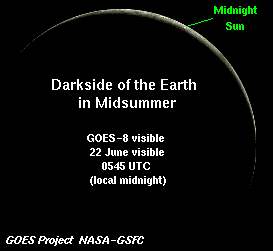 One can use the
Starry Night
program for Windows and the Macintosh to simulate the appearance of
the sky at any time, from any chosen vantage point in the Solar System. Thus, by
choosing different points on the surface of the Earth at different times of the
year, this program can be used to show the motion of the Sun through the sky and
illustrate clearly the preceding points about the causes for the seasons. Here
is an extreme example: One can use the
Starry Night
program for Windows and the Macintosh to simulate the appearance of
the sky at any time, from any chosen vantage point in the Solar System. Thus, by
choosing different points on the surface of the Earth at different times of the
year, this program can be used to show the motion of the Sun through the sky and
illustrate clearly the preceding points about the causes for the seasons. Here
is an extreme example:
In the N. Hemisphere Summer at latitudes above the Arctic Circle (23.5
degrees away from the N. Pole) the Sun stays above the horizon for the entire
day (midnight sun). The adjacent image illustrates the midnight sun.
This
GOES-8 weather satellite
visible light image is taken from a vantage point high
above the western hemisphere, with the North at the top. Even though the local
time for the longitude line under the satellite is near midnight, the
Northernmost portion of the globe is illuminated by sunlight (the lighted
portion actually extends below the arctic circle in this image because of
sunlight scattering in the atmosphere).
This simulation of the
midnight sun was made using the
Starry Night program with a "fisheye lens" perspective to show a wide (180 degree)
region of the sky from a vantage point at the North Pole on July 4, 1996. As the
movie illustrates, the Sun moves more or less parallel to the horizon and never
goes below it during the course of a day at these latitudes at this time of the
year. Conversely, in the N. Hemisphere Winter the Sun never comes above
the horizon for the entire day at this latitude. This is an extreme example of
the difference in insolation in Winter and Summer for the N. Hemisphere that is
responsible for the seasons.
Rotation Axis Procession
The Earth's rotation axis is not fixed in space. Like a rotating toy top, the
direction of the rotation axis executes a slow precession with a period of
26,000 years (see following figure).

Pole Stars are Transient
Thus, Polaris will not always be the Pole Star
or North Star. The Earth's rotation axis happens to be pointing almost exactly
at Polaris now, but in 13,000 years the precession of the rotation axis will
mean that the bright star Vega in the constellation Lyra will be approximately
at the North Celestial Pole, while in 26,000 more years Polaris will once again
be the Pole Star.
Precession of the Equinoxes
Since the rotation axis is precessing in
space, the orientation of the Celestial Equator also precesses with the same
period. This means that the position of the equinoxes is changing slowly with
respect to the background stars. This precession of the equinoxes means
that the right ascension and declination of objects changes very slowly over a
26,000 year period. This effect is negligibly small for casual observing, but is
an important correction for precise observations.
The Dawning of the Age of Aquarius (Almost)
Because of the precession of
the equinoxes, the vernal equinox moves through all the constellations of the
Zodiac over the 26,000 year precession period. Presently the vernal equinox is
in the constellation Pisces and is slowly approaching Aquarius.
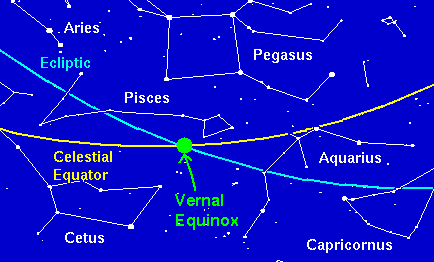
The Vernal Equinox |
|
This is the origin of the "Age of Aquarius" celebrated in the musical
Hair: a period when according to astrological mysticism and related
hokum there will be unusual harmony and understanding in the world. We could
certainly use a dose of harmony and understanding in this old world;
unfortunately, it is unlikely to come because of something as irrelevant as the
position of the vernal equinox with respect to the constellations of the Zodiac.
| 

